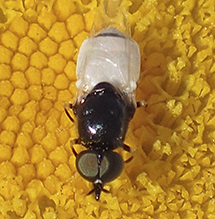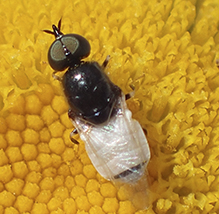soldier fly
(Nemotelus kansensis)
Conservation • Description • Habitat • Ecology • Distribution • Taxonomy
Conservation Status |
|
|||||||
| IUCN Red List | not listed |
|||||||
| NatureServe | not listed |
|||||||
| Minnesota | not listed |
|||||||
Description |
||
Nemotelus kansensis is a small soldier fly. Flies in its genus are among the smallest soldier flies. It occurs in the United States from New York to Maryland, west to South Dakota and Kansas, and south to eastern Texas. It also occurs in southern Ontario Canada and in Monterrey Mexico. The larvae are aquatic, living in water. They feed on organic matter. Adults are found on flowers near water. They feed on flower nectar. Females are 3 ⁄16″ (4.5 mm) in length. The head is long, round, flat, entirely black, and shiny. It is moderately sparsely covered with short, appressed, silky hairs. The front of the face is strongly produced forward, cone shaped. The compound eyes are widely spaced at the top of the head. The antennae are short and black. They have seven segments and are inserted halfway between the compound eyes and the tip of the face. There is a short, bristle-like appendage (arista) at the tip. The tube-like collection of mouthparts (proboscis) is long, black, sharply bent in the middle, and curved on the outer half. The mouthparts are adapted for feeding from the long disk florets of coneflowers. The thorax is moderately sparsely covered with short, appressed, silky hairs in the middle, more densely on the sides. It is entirely black except for a very thin white line on each lateral margin. It does not have a greenish tinge. The abdomen is shiny, hairless, and black with white markings. It does not have a greenish tinge. The first segment is short and unmarked. The second, third, and fourth segments each have a white, forward-pointing triangle in the middle. The fourth and fifth segments have a narrow white band on the rear margin. On the fourth segment the white triangle merges with the white band. The second through fifth segments have a continuous, narrow, white stripe on each lateral margin that merges with the band on the rear of the fifth segment. The wings are clear. The veins are white except for those on the leading (costal) margin, which are yellow. The discal cell is rather large. Four veins extend from the discal cell to the outer margin. The fourth vein originates in the basal third of the underside of the discal cell. The knob at the tip of each balancing organ (haltere) is white. The third leg segment (femur) is mostly black, yellowish just at the tip. The fourth leg segment (tibia) is black in the middle, merging to yellowish at each end. The last part of the leg (tarsus), corresponding to the foot, is yellowish. Males are smaller, ⅛″ (3.5 mm) in length. The compound eyes meet at the top of the head. The facial protuberance is shorter and more slender, and there are two small white spots at the base on the upper side. The antennae are inserted at the base of the protuberance. The abdomen is entirely white. The tibiae on the hind legs has a black spot. |
||
Size |
||
Females: 3 ⁄16″ (4.5 mm) Males: ⅛″ (3.5 mm) |
||
Similar Species |
||
Habitat |
||
Near water |
||
Ecology |
||
Season |
||
|
||
Behavior |
||
When at rest, wings are held over the back overlapping each other, like a closed pair of scissors. |
||
Life Cycle |
||
|
||
Larva Food |
||
Organic matter |
||
Adult Food |
||
Flower nectar |
||
Distribution |
||||
|
Sources |
|||
| 5/29/2023 | ||||
Occurrence |
||||
|
||||
Taxonomy |
|||
Order |
Diptera (Flies) | ||
Suborder |
Brachycera | ||
| Infraorder | Orthorrhapha | ||
| Parvorder | Stratiomyomorpha (soldier flies and allies) | ||
| Superfamily | Stratiomyoidea | ||
Family |
Stratiomyidae (soldier flies) | ||
Subfamily |
Nemotelinae | ||
| Subtribe | Nemotelinae | ||
Genus |
Nemotelus | ||
Subgenus |
Nemotelus | ||
Synonyms |
|||
Nemotelus plesius Nemotelus trinotatus |
|||
Common Names |
|||
This species has no common name. The common name for the family Stratiomyidae is soldier flies, and it is applied here for convenience. Fontenelle Forest, a private conservation organization in Nebraska, uses the common name “Kansas soldier fly” for this species. No other source can be found that uses any common name for the species. |
|||
Glossary
Arista
A large bristle on the upper side of the third segment of the antenna of a fly. Plural: aristae.
Costal margin
The leading edge of the forewing of insects.
Femur
On insects and arachnids, the third, largest, most robust segment of the leg, coming immediately before the tibia. On humans, the thigh bone.
Halteres
In flies: a pair of knob-like structures on the thorax representing hind wings that are used for balance.
Proboscis
The tube-like protruding mouthpart(s) of a sucking insect.
Tarsus
On insects, the last two to five subdivisions of the leg, attached to the tibia; the foot. On spiders, the last segment of the leg. Plural: tarsi.
Tibia
The fourth segment of an insect leg, after the femur and before the tarsus (foot). The fifth segment of a spider leg or palp. Plural: tibiae.
Visitor Photos |
|||||
Share your photo of this insect. |
|||||
| This button not working for you? Simply email us at info@MinnesotaSeasons.com. Attach one or more photos and, if you like, a caption. |
|||||
Babette Kis |
|||||
Nemotelus kansensis small soldier fly, male with white abdomen Nemotelus kansensis, soldier fly, on oxeye daisy at Barnes Prairie, Racine Co., WI on June 23, 2022. |
 |
||||
 |
|||||
MinnesotaSeasons.com Photos |
|||||
|
|||||

Slideshows |
||

Visitor Videos |
|||
Share your video of this insect. |
|||
| This button not working for you? Simply email us at info@MinnesotaSeasons.com. Attach a video, a YouTube link, or a cloud storage link. |
|||
Other Videos |
|||
| SOLDIER FLY, Nemotelus kansensis on daisy. 3021934 Rob Curtis |
|||
About
Jul 22, 2020 SOLDIER FLY, Nemotelus kansensis on daisy. 3021934 Lake Co, IL 6/21/2020 |
|||


Created: 5/29/2023
Last Updated:

